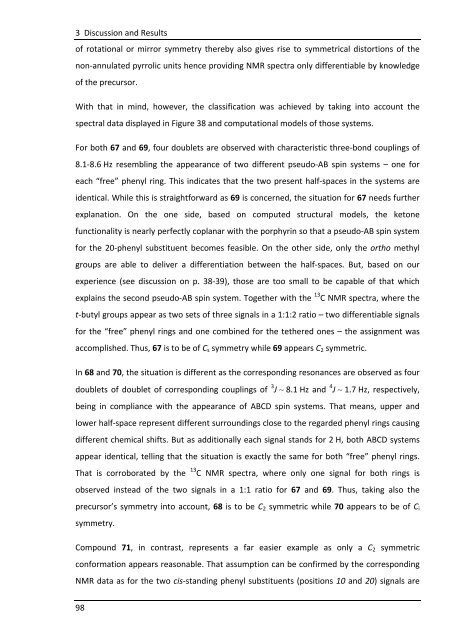1.1 Porphyrins - Friedrich-Alexander-Universität Erlangen-Nürnberg
1.1 Porphyrins - Friedrich-Alexander-Universität Erlangen-Nürnberg
1.1 Porphyrins - Friedrich-Alexander-Universität Erlangen-Nürnberg
Create successful ePaper yourself
Turn your PDF publications into a flip-book with our unique Google optimized e-Paper software.
3 Discussion and Results<br />
of rotational or mirror symmetry thereby also gives rise to symmetrical distortions of the<br />
non-annulated pyrrolic units hence providing NMR spectra only differentiable by knowledge<br />
of the precursor.<br />
With that in mind, however, the classification was achieved by taking into account the<br />
spectral data displayed in Figure 38 and computational models of those systems.<br />
For both 67 and 69, four doublets are observed with characteristic three-bond couplings of<br />
8.1-8.6 Hz resembling the appearance of two different pseudo-AB spin systems – one for<br />
each “free” phenyl ring. This indicates that the two present half-spaces in the systems are<br />
identical. While this is straightforward as 69 is concerned, the situation for 67 needs further<br />
explanation. On the one side, based on computed structural models, the ketone<br />
functionality is nearly perfectly coplanar with the porphyrin so that a pseudo-AB spin system<br />
for the 20-phenyl substituent becomes feasible. On the other side, only the ortho methyl<br />
groups are able to deliver a differentiation between the half-spaces. But, based on our<br />
experience (see discussion on p. 38-39), those are too small to be capable of that which<br />
explains the second pseudo-AB spin system. Together with the 13 C NMR spectra, where the<br />
t-butyl groups appear as two sets of three signals in a 1:1:2 ratio – two differentiable signals<br />
for the “free” phenyl rings and one combined for the tethered ones – the assignment was<br />
accomplished. Thus, 67 is to be of Cs symmetry while 69 appears C2 symmetric.<br />
In 68 and 70, the situation is different as the corresponding resonances are observed as four<br />
doublets of doublet of corresponding couplings of 3 J ∼ 8.1 Hz and 4 J ∼ 1.7 Hz, respectively,<br />
being in compliance with the appearance of ABCD spin systems. That means, upper and<br />
lower half-space represent different surroundings close to the regarded phenyl rings causing<br />
different chemical shifts. But as additionally each signal stands for 2 H, both ABCD systems<br />
appear identical, telling that the situation is exactly the same for both “free” phenyl rings.<br />
That is corroborated by the 13 C NMR spectra, where only one signal for both rings is<br />
observed instead of the two signals in a 1:1 ratio for 67 and 69. Thus, taking also the<br />
precursor’s symmetry into account, 68 is to be C2 symmetric while 70 appears to be of Ci<br />
symmetry.<br />
Compound 71, in contrast, represents a far easier example as only a C2 symmetric<br />
conformation appears reasonable. That assumption can be confirmed by the corresponding<br />
NMR data as for the two cis-standing phenyl substituents (positions 10 and 20) signals are<br />
98

















